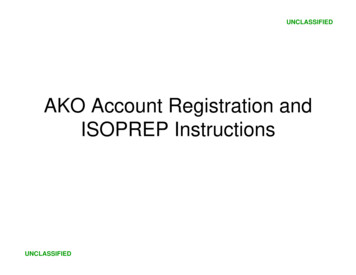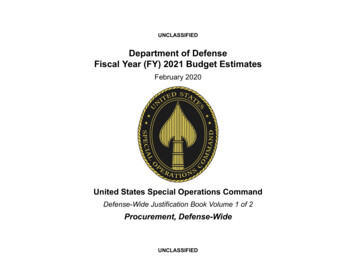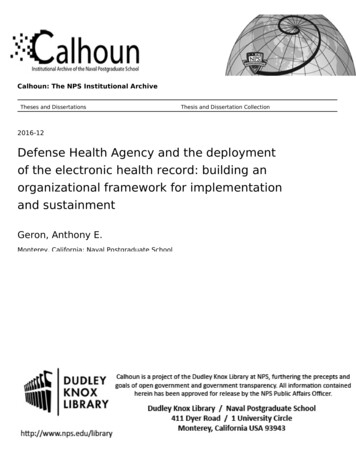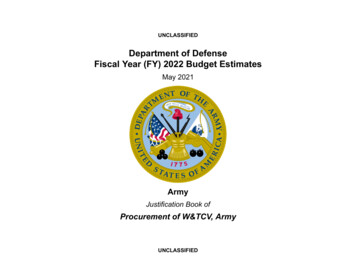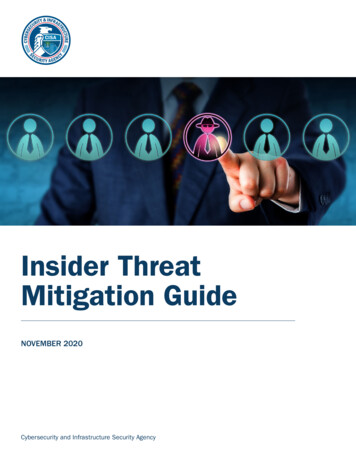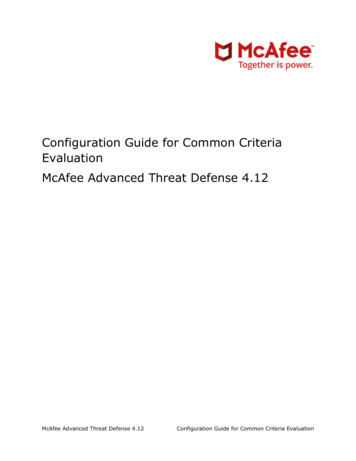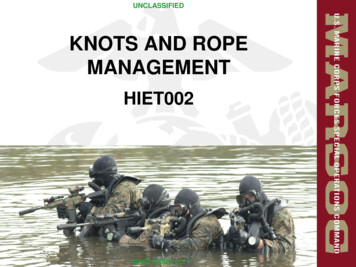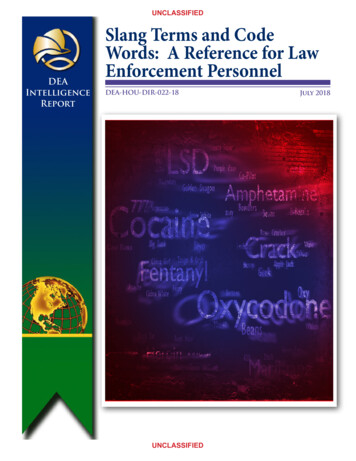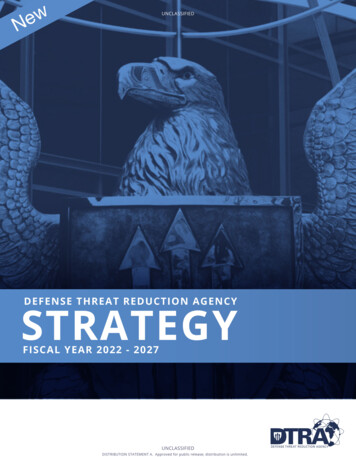
Transcription
UNCLASSIFIEDD IREC TOR ’S FOR EW O R DIn his Interim National Security Strategic Guidance, published in March of 2021, PresidentBiden focused the Nation’s instruments of power on China and Russia as “pacing threats,”in a frankly acknowledged shift to strategic competition. Secretary of Defense Austin’spublished priorities for the DoD have done the same. These developing strategieshave revectored the Nation’s national security interest in partnerships and internationalleadership; on securing the homeland; and in mounting an effective, integrated deterrentto adversary use of weapons of mass destruction (WMD) and emerging threats.The responsibility of the Defense Threat Reduction Agency’s (DTRA’s) strategy is not toset our own course – by interpreting or revising this higher-level guidance – but to alignus with Department and National priorities. Joint Publication 3-0 defines strategy as:“ A prudent idea or set of ideas for employing the instruments of national powerin a synchronized and integrated fashion to achieve theater, national, and/ormultinational objectives.”It is in that spirit the 2022-2027 DTRA Strategy highlights the administration’s theater,national, and/or multinational objectives, as set by our National leaders; reminds us of ourcore functions (DTRA’s unique instruments of national power); and then aligns those uniqueinstruments with four Agency goals – our own set of ideas to achieve those objectives.DTRA’s mission is complex and dynamic, in large part because of the complex anddynamic nature of WMD themselves. This universe includes not only threat agents,but their related expertise, components, technologies, and means of delivery – fromadversary conceptualization and development through U.S. forces’ mitigation andrecovery. The four goals outlined here will act as a lens (in concert with our AgencyCharter and internal Planning Guidance) to help focus our operations, activities, andinvestments to ensure our path and outcomes remain consistent with National andDepartmental priorities.For the DTRA workforce: as you employ this lens, I ask that you reach across functionalboundaries, reach across Directorate lines, and bring to bear the full, integrated capabilityof DTRA’s incredible workforce. Employ the expertise and values (including innovation,agility, inclusivity, and mission focus) that ensure we are capable of accomplishing ourmission, and help us aspire to our Agency vision as the premier National Security agencyto address the challenges posed by WMD and emerging threats.Rhys M. Williams, Ph.D.Director (acting)Defense Threat Reduction Agency2UNCLASSIFIED
UNCLASSIFIEDDEFENSE THREAT REDUCTION AGENCY STRATEGYSTR ATE GI C EN V I R O N M E N TOutpacing the ThreatsThe United States faces a complex and volatile security landscape. As identified by SecretaryAustin’s 2021 Defense Planning Guidance, China remains the pacing threat and seeks to replacethe current international rules-based order with one centered on Beijing. While Russia doesnot pose the same long-term military, economic, or diplomatic challenges as China, it too ishighly capable, and seeks near- to medium-term hegemony within its region. Both seek tochallenge the United States regionally and on the global stage. North Korea also challengesthe security of the United States and our allies. While it does not present the same challengesposed by China or even Russia, the Agency must keep a watchful eye on North Korean WMDprograms. For China, Russia, and North Korea, nuclear, biological, and/or chemical weaponsremain an enduring concern. Regarding Iran, Secretary Austin’s 2021 Defense PlanningGuidance directs the Department to accept greater risk, while still monitoring the overallthreat posed to U.S. and regional interests.The effort to counter China’s growing assertiveness aligns with national strategy andplanning priorities. The 2021 Interim National Security Strategic Guidance states “China isthe only competitor potentially capable of combining its economic, diplomatic, military,and technological power to mount a sustained challenge to a stable and open internationalsystem.” The draft 2022 National Defense Strategy also highlights China as the “pacing threat”to U.S. interests and international order. As China continues to expand its influence aroundthe globe, the United States will strengthen its own relationships with allies and partners. The2021 Interim National Security Strategic Guidance highlights “reinvigorating and modernizing ouralliances and partnerships around the world” as crucial to countering current and emergingWMD threats from China.When referring to WMD, the Agency is specifically focused on nuclear, chemical, and/orbiological weapons. Guidance in the draft 2022 National Defense Strategy references emergingthreats as “new or enhanced materials or methodologies, potentially including the threat itself;its formulation, development, or production; and/or its propagation, transfer, or delivery.”For WMD, then, the development of materials or methodologies with the potential to createnew, or increase the impact of existing forms of traditional WMD can be considered “emergingthreats.” A novel pathogen, a new means to deliver chemical or biological weapons, or theuse of traditional WMD material in new (or previously unknown) ways, for instance, can allbe seen in this light.Whether current or emerging, WMD offer adversaries the ability to enhance their coerciveinfluence and possibly offset U.S. conventional military advantages. This is not to say thethreat is uniform. Each of our potential adversaries maintains (or is developing) uniqueWMD capabilities to achieve specific aims. Additionally, the potential for natural or accidentalrelease of threat agents – wholly unrelated to adversary action – contributes to an everevolving nuclear, biological, and chemical maneuver space. The Coronavirus Disease 2019(COVID-19) pandemic has demonstrated how a biological event can impact public health,UNCLASSIFIED3
UNCLASSIFIEDsecurity, and the economy on a global scale. In response, current national security anddefense guidance stresses the importance of increasing biodefense and biosurveillanceefforts with our international partners. The 2021 Interim National Security StrategicGuidance states, “We will join with the international community to combat the continuingthreat posed by COVID-19 and other infectious diseases with pandemic potential. ”TheSecretary of Defense has renewed DoD’s focus on domestic health, safety, and security.The 2021 National Strategy for the COVID-19 Response and Pandemic Preparedness callsfor the U.S. government to “[build] better biopreparedness and expand resilience forbiological threats.”This 2022-2027 DTRA Strategy outlines the Agency’s approach to detect, deter, and defeatcurrent and emerging WMD threats. Within policy guidance, we will use creative approachesto leverage and expand existing DoD, USG, and international partnerships so the JointForce and our allies and partners are prepared to prevail in WMD environments acrossthe continuum of strategic competition, conflict, and post-conflict recovery. DTRA willleverage its unique role as both a Combat Support Agency (CSA) and Defense Agency (DA)to provide the capabilities required to meet the challenges of the coming decade.MISSIONDTRA enables the DoD, U.S. Government (USG), and international partners to counterand deter WMD and emerging threats.VISIONDTRA is the premier Agency to address WMD and emerging threats challenges. Ourinnovation and agility mitigate these threats in measurable ways, and empower ourallies and partners to do the same.4UNCLASSIFIED
UNCLASSIFIEDDEFENSE THREAT REDUCTION AGENCY STRATEGYAGENCY FUNCTIONS AND GOALSThis Strategy supports national-level guidance through DTRA-specific goals and functions.The DTRA goals are the outcomes we seek to achieve as an Agency, while the Agencyfunctions are the unique ways by which we achieve its Mission and goals. DTRA’s goalscut across its many activities and capabilities, including nuclear security and surety; armscontrol and verification; cooperative threat reduction; building partner capacity; planning,training, and exercising; and developing capabilities.Below are DTRA’s core functions, which underpin the Agency’s strategic goals. The specificsoffered within these goals and functions are meant to exemplify how DTRA affects theoperating environment within each. They do not constitute an exhaustive list.GOALS:FUNCTIONS:DTRA Enables StrategicDeterrenceEnsure A Safe, Secure,Reliable, And EffectiveNuclear DeterrentDTRA Supports U.S.Treaty ImplementationAnd VerificationCounter Weapons OfMass Destruction AndEmerging ThreatsDTRA Partners To ReduceGlobal WMD ThreatsEnable The Joint ForceAnd Allies/PartnersTo Compete And WinAgainst AdversariesDTRA IdentifiesVulnerabilities AndMitigation StrategiesBuild An Adaptive AndResilient AgencyDTRA DevelopsAnd Delivers RapidCapabilitiesUNCLASSIFIED5
UNCLASSIFIEDA GE NCY FU N CT I O NS :DTRA ENABLES STRATEGIC DETERRENCEThe Agency’s world-class nuclear experts advise and train the warfighter, ensuring the safetyand effectiveness of the U.S. nuclear deterrent. DTRA nuclear surety experts maintain aviable strategic deterrent through a number of activities. They provide nuclear sustainmentsupport to the Combatant Commands and the broader Joint warfighter. They conductMission Assurance Assessments to ensure the proper function and resilience of DefenseDepartment nuclear security activities and the related support infrastructure. They modelnuclear weapons effects to inform protection and response efforts from nuclear attacks.They also wargame and analyze the challenges and opportunities associated with integrateddeterrence to identify potential vulnerabilities and improvements in current DefenseDepartment capabilities or plans.D TRA S UP POR T S U. S . TR E A TYIMPLEM ENT A T I O N A N D V E R IF IC A TIO NThe Agency reduces threats to the United States and supports strategic stability by supportingarms control agreement implementation activities and preparing for future monitoring andverification requirements. DTRA arms control implementation experts protect U.S. equitiesduring and after negotiations through a number of activities. These include conductingon-site inspections, monitoring compliance, and escorting activities for foreign arms controlinspectors. These actions take place under various treaties, such as the New Strategic ArmsReduction Treaty and the Chemical Weapons Convention.DTR A P A R T N ER S T O R E D U C E G L O B A LWMD THR EA T SThe Agency deepens and strengthens relationships with key allies and partners throughthe use of exchange and liaison officers, strategic dialogues, and various cooperation andpartner capacity building activities. DTRA engages with allies and partners on nuclear,biological, and chemical security engagements, to include activities designed to counteremerging WMD threats. In recent years, disease surveillance, detection, identification,reporting, and response operations increased opportunities for cooperation. Meanwhile,the ongoing activities of maritime and border security operations to enable WMD interdictionsremain critical. All of these efforts allow DTRA to build our partner nation’s countering WMD(CWMD) capabilities and reduce WMD threats across the globe.6UNCLASSIFIED
UNCLASSIFIEDDEFENSE THREAT REDUCTION AGENCY STRATEGYA GE NCY FU N CT I O NS :D TRA ID EN T I FI ES V U L N E R A B IL ITIE SAND M I T I GA T I ON S TR A TE G IE SThe Agency examines current and emerging WMD vulnerabilities to enable the Joint Forceto mitigate these vulnerabilities. Agency subject matter experts, analysts, planners, andstrategists examine scenarios related to potential future conflicts with WMD-capableadversaries and emerging WMD threats. Further, DTRA assesses developments amongscientific disciplines, technologies, and materials that may shape or advance WMD threatsand opportunities, including strategic and operational analyses focused on the 2022 NationalDefense Strategy priorities of China and Russia. These activities allow the Agency to planand staff for crises or contingencies. Finally, these strategies and expertise prepare theJoint Force for meeting WMD challenges and potential conflict.D TRA DEV EL O PS A N D D E L IV E R SR APID CA P A BI L I T I E SThe Agency is a key developer of capabilities to counter current and emerging WMDthreats. These capabilities vary, to include new types of medical therapeutics, WMDdetection capabilities, force protection efforts, and key technologies that enable theJoint Force to defeat, disable, and dispose of adversary WMD threats. Recent capabilitydevelopment successes include wearable technology that can identify when individualsbecome infected with a pathogen prior to displaying symptoms, advanced diagnosticsthat can identify exposure to non-traditional chemical agents, modeling and data analysistools to aid in the fight against the COVID-19 pandemic, and new means of hardeningsystems to survive a nuclear detonation that allow critical systems to continue operating.Finally, as elucidated in DTRA’s founding legislation, the collective impact of these corefunctions should create the “institutional means” for a more focused DoD responseto the security challenges posed by WMD. The Agency uses its depth and breadth,its partnerships, and its dual roles as both a CSA and DA to help synchronize tactics,operations, and strategy development, for measurable effects across the counter-WMDthreat space.UNCLASSIFIED7
UNCLASSIFIEDA GE NCY G O ALS :With these core functions in mind, below are the Agency goals used to drive programs,operations, activities, and investments. Again, the descriptions of each goal includeexemplary – not all-inclusive – milestones designed to showcase Agency output.1. E NSUR E A SA FE, S E C U R E , R E L IA B L E , A N DEFFECT I V E N UCL E A R D E TE R R E N TA strong nuclear arsenal underpins the security of the United States and our allies. China,Russia, and North Korea are modernizing and expanding their nuclear forces. Potentialadversaries view nuclear weapons as a means to challenge the United States and its allies.DTRA supports the U.S. nuclear deterrent through nuclear readiness and modernization,mission assurance, force preparedness, and treaty verification. In an evolving and evercomplex geopolitical environment, the Agency’s primary goal is to support the strategicdeterrent. To this end, the Agency will:OBJECTIVESEnsure U.S. nuclear forces remain mission-capable and resilient against currentand emerging WMD threats;Expand nuclear operations expertise, to include insight into adversary capabilitiesacross the Joint Force and civilian leadership;Examine and improve USG readiness and ability to develop and implementfuture verification regimes, while also protecting U.S. equities during andafter negotiations; andIncrease DoD policymakers’, planners’, and warfighters’ ability to detect, deter,and defeat the entire spectrum of nuclear coercion and aggression.In an evolving and ever complex geopoliticalenvironment, the Agency’s primary goal isto support the strategic deterrent.8UNCLASSIFIED
UNCLASSIFIEDDEFENSE THREAT REDUCTION AGENCY STRATEGYA GE NCY G O ALS :2. C OUN T ER WEA PO N S O F M A S S D E S TR U C TIONAND EM ER GI NG TH R E A TSOBJECTIVESAgency activities improve the Joint Force’s ability to interdict WMD proliferation and securevulnerable WMD materials. China, Russia, and North Korea all have confirmed WMD stockpiles,and all seek to undermine U.S. and allied interests. Agency subject matter experts conductmulti-domain and trans-regional analysis on WMD threats at the strategic and operationallevel. The Agency also assesses trends among scientific disciplines, technologies, and materialsthat may shape or advance WMD threats and opportunities. These efforts impact the Agency’sefforts focused on developing and adapting new technologies to counter WMD threats forthe Joint Force, along with our allies and partners. By combining cutting edge research anddevelopment efforts with sustained engagement and security cooperation initiatives focusedon countering WMD threats, DTRA improves the Joint Force and partner nations’ ability tosecure vulnerable WMD materials and to mitigate threats posed by nuclear, chemical, andbiological weapons. To this end, the Agency will:Deepen and broaden partnerships in regions where WMD-armed adversariesseek to undermine U.S. objective by working with Defense Department Policyoffices, the Combatant Commands, and the Interagency;Increase understanding of emerging WMD threat trends, particularly in regardsto novel adversary employment options;Explore new avenues for the Joint Force and allies and partners to fight and winin WMD environments; andIncrease DTRA’s role in the planning process, particularly against emergingWMD threats. DTRA improves the Joint Force and partnernations’ ability to secure vulnerable WMDmaterials and to mitigate threats posed bynuclear, chemical, and biological weapons.UNCLASSIFIED9
UNCLASSIFIEDA GE NCY G O ALS :3. E NA B L E T HE J O I N T F O R C E A N DALLI ES/ PA R T NERS TO C O M P E TEAND WI N A GA I N S T A D V E R S A R IE SOBJECTIVESThe Agency enhances the Joint Force, allied, and partner ability to compete and, whennecessary, win against potential WMD-armed adversaries. Today, potential adversariesbelieve that WMD are critical to shape the battlespace, exert coercive influence, andachieve military aims. The impact of conflicts with WMD-armed adversaries are mitigatedby developing counter-WMD technical solutions, highlighting WMD warfighting challengesand adversary vulnerabilities through strategic and operational analysis, and supportingDoD plans and exercises focused on CWMD threats. The Agency provides the Joint Force,allies, and partners with unique insight into adversary WMD force posture, doctrine, andsystems. In particular, DTRA examines how potential adversaries plan to employ andintegrate WMD during conflict. This better prepares U.S. and allied forces for overmatchwithin a WMD battlespace. To this end, the Agency will:Expand our ability to identify, characterize, and exploit adversary WMD vulnerabilities;Strengthen target characterization and servicing requirements for WMD hard targets;Develop non-traditional planning solutions to emerging WMD problems, to includepreventing further WMD employment following adversary first use; andRecognize potential WMD warfighting obstacles as well as potential solutions toenable the Joint Warfighter to win during conflict.The Agency will recognize potential WMDwarfighting obstacles as well as potentialsolutions to enable the Joint Warfighterto win during conflict.10UNCLASSIFIED
UNCLASSIFIEDDEFENSE THREAT REDUCTION AGENCY STRATEGYA GE NCY G O ALS :4. BUIL D A N A D A PTIV E A N D R E S IL IE N T AGENCYOBJECTIVESAgility, adaptability, and flexibility reduce risk from future unprecedented and unexpectedWMD events. To this end, we must recruit and retain the highly skilled workforce necessary tounderstand and counter emerging WMD threats. The Agency workforce must include thosewho both understand the past two decades of conflict and, more importantly, focus on thepotential conflicts of the next two decades. The Agency will reflect the changes in the broaderAmerican landscape. It will be a workforce that is more diverse, inclusive, and representativeof the changing demographics in our country. Further, we will have collaborative suites ofinformation technology tools that enable conceptualization, understanding, and collaborationwithin the workforce. By combining a workforce with a diverse set of expertise, skills, andbackgrounds with innovative technical solutions, DTRA will enable DoD to respond to crisesand develop solutions to detect, deter, and defeat current and emerging WMD threats. To thisend, the Agency will:Increase the relative percentage of entry level and early career professionals;Shift the makeup of the workforce to better align with the nation’sdemographics; andRealize a workspace that facilitates greater and more meaningfulcollaboration, to include in-person, virtual, and mixed.C ONC L USI O NDTRA, as the pre-eminent CWMD Agency in the USG, is prepared to meet the challengesof our ever-evolving security environment. We are ready to support the efforts of ourwarfighters, the USG, allies, and partners as the nation competes with global competitors.The Agency provides, and will continue to provide, necessary capabilities, expertise, andprograms to support a robust U.S. national defense against WMD to ensure the DoDand Joint warfighter, USG, allies, and partners prevail across the continuum of strategiccompetition, conflict, and post-conflict recovery.UNCLASSIFIED11
UNCLASSIFIEDDEFENSE THREAT REDUCTION AGENCYDefense Threat Reduction Agency8724 John J. Kingman Road, Stop 6201Fort Belvoir, Virginia 22060-6201www.dtra.milUNCLASSIFIED
The 2021 National Strategy for the COVID-19 Response and Pandemic Preparedness calls for the U.S. government to "[build] better biopreparedness and expand resilience for biological threats." This 2022-2027 DTRA Strategy outlines the Agency's approach to detect, deter, and defeat current and emerging WMD threats.
